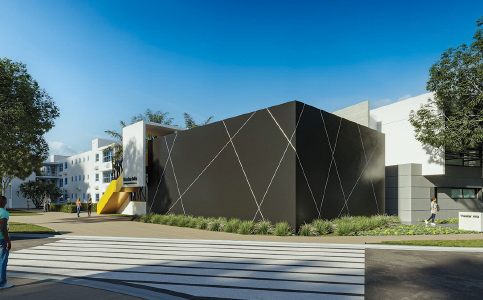University of Miami vast development program speeds up

Advertisement

Changes to the physical plant of the University of Miami that are projected as multimillion-dollar developments continue after a pandemic hiatuses.
After the university announced plans to build Centennial Village, a freshmen on-campus housing project on the Hecht Residential College site, in January 2019, work to demolish the property on site is to begin in May. The university announced in December that preconstruction for the $335 million project, contracted and designed by VMDO Architects and Coral Gables-based Zyscovich Architects, would begin during the first months of the year, after the Covid-19 pandemic delayed its progress.
The Hecht Residential College would close to allow for demolition and construction during the coming summer. Then, during the summer of 2024, the Stanford Residential College and the Hecht-Stanford Dining Hall would close. In the fall of 2024, the first and second residential colleges would open, including its new dining hall, and in the fall of 2026, the third, fourth and fifth residential colleges would open.
In a press release, Jacqueline A. Travisano, executive vice president for business and finance and chief operating officer of UM, said the university is “delighted to resume progress towards completion of our multiyear plan to modernize our housing on campus.”
During the first phase of construction, freshmen students would live in Stanford Mahoney and the Pearson residential colleges, said the press release. Sophomores would live in Easton Residential College and Lakeside Village, and juniors and seniors would live in University Village. The Centennial Village is the second phase of the university’s modernization plan for student housing.
The new Centennial Village would house about 2,025 students with the construction of a residential college. Previous plans for the building included four residential colleges, housing 1,700 first-year students.
The university’s Knight Center for Music Innovation is another large project, which is expected to be completed in spring 2023. The 25,000-square-foot performance and technology center at the Phillip and Patricia Frost School of Music, facing Lake Osceola, is designed by Arquitectonica’s H3 and costs $34 million.
Equipped with a 200-seat recital hall, a large black-box innovation space, recording, lighting and broadcast technology, and outdoor performance spaces at the Newman Plaza, the Knight Center for Music Innovation “will enhance our ability to leverage new and emerging technologies to deliver groundbreaking experiences to some of the world’s most gifted and rising talent and prepare them to positively impact the communities where they work, perform, and serve,” said Shelly Berg, dean of the Frost School of Music, in a press release.
This project, now under construction, would be part of UM’s Ever Brighter campaign, which seeks to position the university in community betterment projects and philanthropy.
In addition, the Frost Institute for Chemistry and Molecular Science, a 94,000-square-foot, five-story lab facility east of the McLamore Fountain on Memorial Drive, is to open this summer, after three years of planning and design and several months of site preparation – construction began last October – said a press release earlier this year.
The $60 million project is the first of a group of interdisciplinary research centers that would operate under the Frost Institute for Science and Engineering of the University of Miami. The Frost Institutes developments started in 2017, after Phillip and Patricia Frost announced a $100 million gift to the university to create a multidisciplinary research hub focused on scientific discovery. The inaugural director of the new institute, who is expected to be announced this summer, would dictate what research will be pursued, the press release said.
The project is designed by Florida-based Harvard Jolly Architecture and built by Skanska, which built the Frost School of Music’s Patricia Louise Frost Studios. It will include a 15,000-square-foot wet lab on the third floor, with moveable wet-lab benches and fixtures, “for the free flow of both ideas and people.” Eventually, after its opening, the fourth and fifth floors would each accommodate another 15,000 square feet of wet-lab space as well. The second floor would house innovation labs for research with residence space for students to stay.
Jessica Brumley, UM’s vice president for facilities, operation and planning, said in a statement that “there is a continued priority in reinvesting capital dollars towards the university’s strategic goals, which include enhancing the student experience, ensuring that our research spaces are of the caliber of a top-tier research university, a commitment to diversity, and excellence across the institution, including athletics.”
UM is also building on campus a new 15,000-square-foot Theater Arts building designed by Mateu Architecture, which is currently in pre-construction. The two-story building would feature a theater, concessions, wardrobe and dressing rooms, acting and dance classrooms, voice studios, a student lounge, and a 1,000-square-foot IT hub and data room, according to a press release. The project is to break ground in the third quarter of the year.


